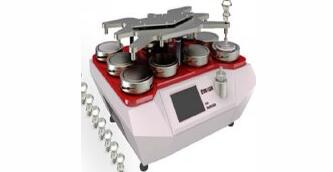-
Abrasion testing machine operation and maintenance procedures
Edited by:Read:The abrasion resistance tester is an abrasion testing machine for elastic materials, rubber, tyres, conveyor belts, transmission belts, shoe soles, soft synthetic leather and leather materials. The abrasion resistance of the specimen is assessed by the number of reversals of the motor as indicated by a counter. The abrasion resistance tester is suitable for the determination of the abrasion of rubber products by opposing abrasion. It is a very suitable testing machine for comparison experiments and for checking and classifying the balance of products.
1.Abrasion resistance testing machine operating procedures.
1.1. Turn on the main power switch, and confirm whether the voltage is normal.

1.2. Take the sole of the shoe with the inner sole and the upper removed as a sample, the test sample is 3. Draw a line along the wide part of the sole, find the centre of this line and then use the cutter to make a single cut parallel to this line and as close to this centre as possible. The cutter should go through the full thickness of the outsole and into the insole, perhaps in the same layer. If several materials make up the sole, another cut should be made, but the cut must be avoided within 15mm of the edge of the sole, using a testing magnifying glass and calipers to measure the length of the initial cut.
1.3. Turn on the power switch of the testing machine, adjust the experimental jig in the centre of the bending position, that is, near the 90 ° position. Loosen the jig hexagonal screws, the prepared style in turn clamped into the jig, tighten the jig hexagonal screws. And cover the safety guard.
1.4. According to the relevant requirements of customers, the number of equipment bending and bending speed, press the start button to start the experiment.
1.5. After the number of experiments, the equipment will stop automatically. 1.5. The final length of the cut on the surface of the specimen is measured by the test magnifying glass and calipers, and the difference between the final cut length and the initial cut length is calculated.
1.6. Record the test results.
2. wear testing machine maintenance procedures.
2.1. After each use of the instrument, first turn off the power supply, unload the equipment on the sample under test, and then use a clean dry cotton cloth to wipe away the dust and dirt on the instrument, completely restore the normal state before use.
2.2. The temperature of the environment in which the instrument is placed should not be too high and the relative humidity should not be too high.
2.3. The instrument should be cleaned externally once from time to time when it is not often used and energised from time to time to avoid causing dampness in the lines and bad conditions.
2.4. The bearing ministries should be lubricated regularly to extend the service life of the equipment.
- 2024-04-19Paper ring compression strength tester standards
- 2024-04-19Cupping tester standards
- 2024-04-19Rubber and plastic tensile tester standards
- 2024-04-19Taber 1750 wear-resistant tester standards
- 2024-04-19Stone Chip Resistance Gravelometer standards
- 2024-04-18Diaper absorption speed tester standards
- 2024-04-18Diaper leakage tester technical indicators
- 2024-04-18Paint film impact resistance tester standards
- 2024-04-18Low temperature brittleness tester principle
- 2024-04-18Battery separator permeability tester technical indicators



